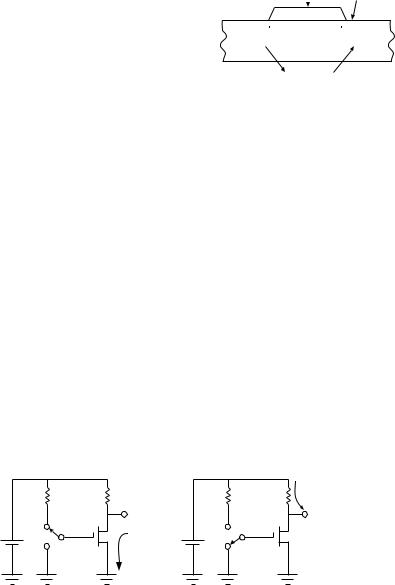
- •Table of Contents
- •Objectives
- •Embedded Microcomputer Applications
- •Microcomputer and Microcontroller Architectures
- •Digital Hardware Concepts
- •Voltage, Current, and Resistance
- •Diodes
- •Transistors
- •Mechanical Switches
- •Transistor Switch ON
- •Transistor Switch OFF
- •The FET as a Logic Switch
- •NMOS Logic
- •CMOS Logic
- •Mixed MOS
- •Real Transistors Don’t Eat Q!
- •Logic Symbols
- •Tri-State Logic
- •Timing Diagrams
- •Multiplexed Bus
- •Loading and Noise Margin Analysis
- •The Design and Development Process
- •Chapter One Problems
- •Organization: von Neumann vs. Harvard
- •Microprocessor/Microcontroller Basics
- •Microcontroller CPU, Memory, and I/O
- •Design Methodology
- •The 8051 Family Microcontroller
- •Processor Architecture
- •Introduction to the 8051 Architecture
- •8051 Memory Organization
- •8051 CPU Hardware
- •Oscillator and Timing Circuitry
- •The 8051 Microcontroller Instruction Set Summary
- •Direct and Register Addressing
- •Indirect Addressing
- •Immediate Addressing
- •Generic Address Modes and Instruction Formats
- •8051 Address Modes
- •The Software Development Cycle
- •Software Development Tools
- •Hardware Development Tools
- •Chapter Two Problems
- •Timing Diagram Notation Conventions
- •Rise and Fall Times
- •Propagation Delays
- •Setup and Hold Time
- •Tri-State Bus Interfacing
- •Pulse Width and Clock Frequency
- •Fan-Out and Loading Analysis—DC and AC
- •Calculating Wiring Capacitance
- •Fan-Out When CMOS Drives LSTTL
- •Transmission Line Effects
- •Ground Bounce
- •Logic Family IC Characteristics and Interfacing
- •Interfacing TTL Compatible Signals to 5 Volt CMOS
- •Design Example: Noise Margin Analysis Spreadsheet
- •Worst-Case Timing Analysis Example
- •Chapter Three Review Problems
- •Memory Taxonomy
- •Secondary Memory
- •Sequential Access Memory
- •Direct Access Memory
- •Read/Write Memories
- •Read-Only Memory
- •Other Memory Types
- •JEDEC Memory Pin-Outs
- •Device Programmers
- •Memory Organization Considerations
- •Parametric Considerations
- •Asynchronous vs. Synchronous Memory
- •Error Detection and Correction
- •Error Sources
- •Confidence Checks
- •Memory Management
- •Cache Memory
- •Virtual Memory
- •CPU Control Lines for Memory Interfacing
- •Chapter Four Problems
- •Read and Write Operations
- •Address, Data, and Control Buses
- •Address Spaces and Decoding
- •Address Map
- •Chapter Five Problems
- •The Central Processing Unit (CPU)
- •Memory Selection and Interfacing
- •Preliminary Timing Analysis
- •External Data Memory Cycles
- •External Memory Data Memory Read
- •External Data Memory Write
- •Design Problem 1
- •Design Problem 2
- •Design Problem 3
- •Completing the Analysis
- •Chapter Six Problems
- •Introduction to Programmable Logic
- •Technologies: Fuse-Link, EPROM, EEPROM, and RAM Storage
- •PROM as PLD
- •Programmable Logic Arrays
- •PAL-Style PLDs
- •Design Examples
- •PLD Development Tools
- •Simple I/O Decoding and Interfacing Using PLDs
- •IC Design Using PCs
- •Chapter Seven Problems
- •Direct CPU I/O Interfacing
- •Port I/O for the 8051 Family
- •Output Current Limitations
- •Simple Input/Output Devices
- •Matrix Keyboard Input
- •Program-Controlled I/O Bus Interfacing
- •Real-Time Processing
- •Direct Memory Access (DMA)
- •Burst vs. Single Cycle DMA
- •Cycle Stealing
- •Elementary I/O Devices and Applications
- •Timing and Level Conversion Considerations
- •Level Conversion
- •Power Relays
- •Chapter Eight Problems
- •Interrupt Cycles
- •Software Interrupts
- •Hardware Interrupts
- •Interrupt Driven Program Elements
- •Critical Code Segments
- •Semaphores
- •Interrupt Processing Options
- •Level and Edge Triggered Interrupts
- •Vectored Interrupts
- •Non-Vectored Interrupts
- •Serial Interrupt Prioritization
- •Parallel Interrupt Prioritization
- •Construction Methods
- •Power and Ground Planes
- •Ground Problems
- •Electromagnetic Compatibility
- •Electrostatic Discharge Effects
- •Fault Tolerance
- •Hardware Development Tools
- •Instrumentation Issues
- •Software Development Tools
- •Other Specialized Design Considerations
- •Thermal Analysis and Design
- •Battery Powered System Design Considerations
- •Processor Performance Metrics
- •Benchmarks
- •Device Selection Process
- •Analog Signal Conversion
- •Special Proprietary Synchronous Serial Interfaces
- •Unconventional Use of DRAM for Low Cost Data Storage
- •Digital Signal Processing / Digital Audio Recording
- •Detailed Checklist
- •1. Define Power Supply Requirements
- •2. Verify Voltage Level Compatibility
- •3. Check DC Fan-Out: Output Current Drive vs. Loading
- •4. AC (Capacitive) Output Drive vs. Capacitive Load and De-rating
- •5. Verify Worst Case Timing Conditions
- •6. Determine if Transmission Line Termination is Required
- •7. Clock Distribution
- •8. Power and Ground Distribution
- •9. Asynchronous Inputs
- •10. Guarantee Power-On Reset State
- •11. Programmable Logic Devices
- •12. Deactivate Interrupt and Other Requests on Power-Up
- •13. Electromagnetic Compatibility Issues
- •14. Manufacturing and Test Issues
- •Books
- •Web and FTP Sites
- •Periodicals: Subscription
- •Periodicals: Advertiser Supported Trade Magazines
- •Index

10EMBEDDED CONTROLLER
Hardware Design
of current flows in the control |
|
|
|
|
|
Collector |
|
|
|
|
|
|
|
circuit (the transistor base- |
|
|
|
|
|
P |
|
|
|
|
|
|
|
emitter circuit) to turn the tran- |
Base |
|
|
|
|
|
|
|
|
|
|||
|
|
N |
|
|
|
|
|
|
|
||||
|
|
|
|
|
|
|
|
|
|||||
sistor on. This control current is |
|
|
|
|
|
P |
|
|
|
|
|
|
|
|
|
|
|
|
|
|
|
|
|
|
|
||
|
|
|
|
|
Emitter |
|
|
|
|
Current |
|
||
amplified (multiplied by the gain |
|
|
|
|
|
|
|
|
|
|
|||
|
|
|
|
|
|
|
|
|
|
Flow |
|
||
or beta of the transistor) and |
|
|
|
|
|
“Source” |
|
|
|
|
|
||
Current |
|
Control |
|
|
|
||||||||
allows a larger current to flow in |
|
|
|
|
|
||||||||
|
|
|
|
|
|||||||||
Flow |
|
|
|
|
|
||||||||
|
|
|
|
|
|
|
|
|
|||||
the output circuit (the collector- |
|
|
|
|
|
|
|
|
|
|
|
|
|
|
|
|
|
|
|
|
|
|
|
|
|
|
|
emitter circuit). Once again, the |
|
|
|
|
|
“Sink” |
|
|
|
|
|
|
|
device is not perfect because of |
|
|
|
|
|
|
|
|
|
|
|
|
|
Figure 1-7: Operation of a bipolar PNP transistor. |
|||||||||||||
the resistance, current, gain, and
leakage limitations of real transistors. Bipolar transistors come in two polarities, NPN and PNP, with the difference being the direction in which current flows for normal operation. A
bipolar PNP transistor is shown |
|
Collector |
|
|
|
N |
|
|
|
and modeled in Figure 1-7. |
|
|
|
|
Base |
P |
|
|
|
|
|
N |
|
|
For most of the illustrative circuit |
|
Emitter |
Current |
|
examples in this book, we will be |
|
|
|
|
|
“Sink” |
Flow |
|
|
using NPN transistors, as shown |
Current |
|
||
|
|
|
||
|
|
|
||
|
|
|
|
|
in Figure 1-8. |
Flow |
|
|
|
Control |
|
“Source” |
Mechanical Switches
Figure 1-8: Operation of a bipolar NPN transistor.
Mechanical switches are useful for direct input to digital circuits. One of the more convenient versions is a bank of rocker switches packaged into a module that can fit into the same location as a standard chip. The dual in-line package, or DIP, switch is one of the easiest ways to add multiple switches to a microcontroller design. The mechanical switch has extremely low “on” resistance and high “off” resistance, unlike most semiconductor switches. Figure 1-9 shows a typical DIP switch and the schematic symbol for it.
|
|
N |
|
F |
O |
|
|
|
F |
|
|
O |
|
|
Figure 1-9: 8-position DIP switch and schematic equivalent.

11CHAPTER ONE
Review of Electronics Fundamentals
Transistor Switch ON
Transistors can be configured to function as switches. As can be seen in Figure 1-10, an NPN transistor operating as a current controlled switch can be used to build a simple inverter. It changes a logic one on its input to a logic zero at its output, and vice versa. In this case, logic one is represented as a positive voltage, and a logic zero is represented by zero volts. The logic one input (positive input voltage) is supplied through a resistor from the power supply voltage to the transistor base terminal, resulting in a small base control current into the base.
Transistor Inverter |
|
|
Transistor Inverter |
|
Input 1 -> Output 0 |
|
|
Equivalent Circuit |
|
Resistor |
|
|
|
|
Sources |
|
|
|
|
Current |
“0” |
|
“1” |
“0” |
“1” |
|
|||
+ |
Output |
+ |
|
Output |
|
Sinks |
|
|
Sinks |
Transistor |
Current |
|
Transistor |
Current |
ON |
|
|
ON |
|
(shorted) |
|
|
(shorted) |
|
Transistor Switch “ON” |
|
|
Equivalent Circuit |
|
Figure 1-10: The transistor inverter; input = 1 and transistor ON. The transistor
ON configuration is at left and the equivalent circuit is at right.
The transistor is used because it has gain allowing a larger output current to flow as controlled by a weaker input. When the transistor is turned on as much as it can be, the collector emitter circuit looks almost like a short circuit, effectively connecting the output to ground or zero volts. This gives a logic zero on the collector output. When the transistor collector is shorted to ground, current flows from the supply through the resistor and into the transistor collector to ground. The transistor is said to sink the resistor current into ground. If there is an external load, such as another inverter or gate, connected to the collector output, the transistor can also sink current from the load. This is also referred to as pulling down the output voltage. The current sinking capacity of the transistor limits the number of devices this inverter can drive.

12EMBEDDED CONTROLLER
Hardware Design
Transistor Switch OFF
When the input is connected to logic zero (ground voltage), no current flows into the base of the transistor, since its base and emitter terminals are at the same voltage. When there is no current flowing in the base, the transistor will not allow current to flow in the collector emitter circuit either. As a result, the circuit behaves as if the transistor was removed from the circuit. The output resistor will source current to any potential load. The output is pulled up to the supply voltage, resulting in a logic one at the output. Once again, there is a limit to the resistor’s ability to source current, resulting in a limit to the number of loads that can be attached to this circuit’s output. Notice these two limits are defined by the ability of the transistor to pull down the output, and the resistor’s ability to pull up the output become the main limits to its ability to drive other devices. Gates can be constructed by adding diodes or transistors to the inverter circuit in Figure 1-11.
Transistor Inverter |
|
Transistor Inverter |
|
Input 0 -> Output 1 |
|
Equivalent Circuit |
|
|
Resistor |
|
Resistor |
|
Sources |
|
Sources |
|
Current |
|
Current |
“0” |
“1” |
“0” |
“1” |
+ |
Transistor |
+ |
Transistor |
Input |
OFF |
|
OFF |
(open) |
|
(open) |
|
Sinks |
|
||
|
|
|
|
Current |
|
|
|
Transistor Switch “OFF” |
Equivalent Circuit |
|
|
Figure 1-11: The transistor inverter; input = 0 and transistor OFF.
The transistor OFF configuration is at left and the equivalent circuit is at right.
The FET as a Logic Switch
Most of the logic devices used in highly integrated circuits do not use bipolar transistors. Instead, they use field effect transistors. FETs perform a similar function
to the bipolar transistors discussed earlier, but they are voltage |
|
Drain |
||||
|
||||||
controlled. While the current flowing in the base |
|
|
|
|
|
|
controls bipolar transistors, the voltage between the |
|
Gate |
|
|
|
|
|
|
|
|
|
||
|
|
|
|
|
||
gate and source controls field effect transistors. The |
|
|
|
|
|
|
|
|
|
|
|
|
|
gate voltage of a field effect transistor controls the |
|
|
|
|
|
|
|
|
|
|
|
|
|
current flowing in the drain-source circuit. The |
Figure 1-12: Field |
|
|
|||
symbol for the FET shows the gate to be insulated |
effect transistor (FET) |
|
Source |
|||
schematic diagram. |
|
|||||
|
|
|
||||
from the source-drain circuit, as shown in Figure 1-12.

13CHAPTER ONE
Review of Electronics Fundamentals
This type of FET is referred to as a MOSFET (metal oxide semiconductor FET), since the insulating material is silicon dioxide (SiO2), commonly known as glass (for early devices, the gate was made
of metal). Like bipolar NPN and PNP |
|
|
Conductor |
SiO2 |
||
|
|
Insulator |
||||
|
|
|
|
|||
transistors with opposite polarity, FETs |
|
|
Gate |
|
|
|
come in N- and P- channel varieties. |
|
|
|
|
|
|
|
Drain |
Channel |
Source |
|
||
The N- and P- channels refer to the |
|
|
||||
|
|
|
|
|
|
|
|
|
|
|
|
|
|
polarity of the source drain element |
|
|
Conductors |
|
|
|
of the device. A cross-section view |
|
|
|
|
||
|
|
|
|
|
|
|
of a FET is shown in Figure 1-13. |
Figure 1-13: Field effect transistor cross-section. |
|||||
NMOS Logic
The conductive state of the FET’s channel is what allows or prevents current from flowing in the device. For a typical logic N-channel MOSFET, the channel becomes conductive when the gate has a positive voltage with respect to the source, allowing current to flow between the drain and source terminals. When the gate is at the same voltage as the source, no current flows. The design of MOS logic circuits can be almost exactly equivalent to the bipolar inverter we saw earlier, substituting an N-channel MOSFET for the bipolar NPN transistor. In fact, the most of the early microcontroller integrated circuits were manufactured using variations of this method, and are referred to as NMOS logic. As can be seen from Figure 1-14, the NMOS FET circuit behaves in an equivalent way to the NPN transistor inverter. When the gate (control input) of the NMOS FET is at a positive voltage, the FET is ON, effectively shorting the source and drain pins. When the gate is at 0 volts, the FET is OFF, opening the circuit between the source and drain. Older NMOS logic ICs use this type of circuit. The original 8051 microcontroller was an NMOS processor.
NMOS FET Inverter |
|
NMOS FET Inverter |
|
Input 1 -> Output 0 |
|
Input 1 -> Output 0 |
|
|
|
|
Resistor |
|
|
|
Sources |
|
|
|
Current |
“1” |
“0” |
“1” |
“0” |
+ |
Output |
+ |
NMOS FET |
|
Sinks |
|
|
NMOS FET |
Current |
|
OFF |
ON |
|
|
(open) |
(shorted) |
|
|
|
Figure 1-14: NMOS inverter circuit.
